Customer lifetime value (LTV) is an estimate of the total sum a customer spends on products or services during their relationships with your brand. This metric helps you decide how much to invest in customer acquisition and retention.
Why is Customer Lifetime Value Important?
A whopping 76% of companies deem customer lifetime value to be a crucial concept for their business’s success. This metric defines your customer retention efforts. Since retaining an existing customer is 5-25 times cheaper than acquiring a new one, lifetime value affects your expenditures and overall margin.
Amping up your LTV affects your sales because the probability of selling to loyal customers is around 60-70%. Chances to sell something to newly acquired buyers are 5-20% on average. Better yet, returning clients spend 67% more than first-timers.
Finally, a 5% growth in customer loyalty boosts your average profit by 25-95%. That means that customer lifetime value is the name of the game for your business’s profitability.
To sum it up, LTV underlies your financial objectives and business strategy. Read on to learn which formula to apply to measure your customer lifetime value.
How to Calculate Customer Lifetime Value
There are several ways to calculate LTV. To keep everything clear, stick to the simplest formula:
Value of a purchase ✖ purchase frequency ✖ customer lifespan
To keep you from puzzling over calculating these elements, we made a table. You can pry into it every time you need to measure LTV.
| Metrics | Formula |
|---|---|
| The average value of a purchase |
The annual total revenue / the number of purchases in the same span |
| The purchase frequency | The number of purchases / the number of unique customers for the same time |
| The customer lifespan | The average number of years a customer continues purchasing from your company |
To help you get a clearer view on applying these formulas, let's plug some figures in them.
Example of a Customer Lifetime Value Calculation
Imagine that you sell running shoes to professional athletes. A pair of shoes is worth around $250. You have learned that a runner needs six pairs every year. You launched your business five years ago. Let’s calculate the LTV of your customer, who has been buying from you since your opening.
Average value of a purchase = $250;
Purchase frequency rate = 6 times a year;
Customer lifespan = 5 years.
$250 ✖ 6 ✖ 5 = $7,500
$7,500 is the lifetime value of your most loyal customer.
Knowing your customer lifetime value, you can improve your performance. Explore the ways to employ LTV for your best interests.
How to Use Customer Lifetime Value?
- Improve forecasting
- Find the best clients
- Target the most valuable prospects
- Choose investments for LTV growth
- Discover most profitable acquisition channels
- Increase retention
We’ve already touched on the helpfulness customer lifetime value provides to your business. Now let’s delve deeper into it and uncover how exactly you can use LTV for the benefit of the undertaking.
Improve forecasting
Calculating customer lifetime value allows you to predict your business outcomes for the next year. This metric also allows you to evaluate the future need for your product or service. You can pinpoint how many of your current customers will stay with you for another couple of months, the amount of revenue they’ll bring to the table, and so on.
With this information on hand, you can plan investments in your workforce, innovations, marketing, and so on. You can also figure out how many new customers you need to acquire to meet your business goals.
Find the best clients
Various customers have different value for your business. In some cases, just 5% of buyers account for 35% of a company's revenue. Better yet, a 1% increase in the high-value customer tier drives a 4% growth in total revenue. Thus, your task is to find the segment of your audience that contributes the most to your business’ well-being.
To pinpoint your VIP customers, segment your audience, and calculate the lifetime value for each of the segments. For instance, the running shoe store’s audience may consist of professional runners and teenagers. Athletes buy the most frequently and choose expensive shoes, while teenagers make a purchase once in a while and go for lower-cost options. Meaning, athletes are your VIP clients.
Knowing your VIPs, you can adjust different aspects of your business to their needs and gain more revenue. For example, you can expand the range of shoes for professionals or offer additional services for athletes.
Another option is to make the most profitable clients contribute to your customer acquisition and brand awareness. Professional athletes can recommend your store to their colleagues or social media followers in return for free shoes or other perks.
Target the most valuable prospects
Less than half of prospective customers turn out to be a good fit for a business. However, data on your customer lifetime value can help you attract the most suitable audience.
Knowing your best-paying customers, you can target prospects with similar features. Chances are they will become your VIP clients too. To get the ball rolling, create a buyer persona – follow our guide on building a customer profile.
Once you have a VIP buyer persona analysis at hand, you can focus your marketing strategy on acquiring them. Address your PPC advertising to your most promising prospects, adjust your content marketing to their needs, tailor your offers to provoke their interest.
Choose on your investments in LTV growth
To calculate your customer lifetime value, you need to know at least three metrics: the average order value, the purchase frequency, and a customer lifespan. By pinpointing the weakest spot of these three, you can figure out how to improve LTV and your revenue in general.
If your customer lifespan is too short, you can lengthen it by investing in tactics that drive buyer engagement – content, email marketing, and so on. If the weakest part of your LTV is the average order value, you may resort to such techniques as cross-selling or product bundling. Finally, if you struggle with low purchase frequency, stimulate regular purchases with special offers, discounts, or new product launches.
Consider trying web push notifications to deliver these messages – they provide a nearly 80% open rate and 12% CTR. Try SendPulse’s web push builder to create and send notifications to 10,000 subscribers for free.
Discover the most profitable acquisition channels
Another way to benefit from knowing your customers’ LTV is by finding the most profitable acquisition channel. Take several sources of leads you use and measure the lifetime value for customers who came from these channels. This tactic helps you determine where your most profitable customers originate from.
This data allows you to understand the price you’re willing to pay for each channel. For instance, your blog may bring customers with an LTV of around $500, while PPC advertising results in buyers with a roughly $250 LTV. In this case, it’s better to invest more in your blog development.
Finally, knowing your average LTV, you can decide how much to invest in customer acquisition while staying profitable. This lets you understand how much you’ll need to spend to get new consumers more effectively.
Customer lifetime value allows you to understand your best acquisition channels, find your VIP clients, target the most promising prospects, decide on the distribution of investments, and so on. Now let’s move on to the tactics and best practices you can adopt to increase your LTV.
Increase retention
Lifetime value is key to the most effective strategies for customer retention. It helps you set priorities – which buyer segments to win back first, how much to invest in different channels, and so on.
The more you know about your VIP customers and their interests, the better tactics you can employ to keep them engaged with your brand. A deeper understanding of your audience will help you craft the most relevant loyalty programs, campaigns, and offers.
Email marketing is one of the most efficient ways to boost and maintain your customer retention rate. Leverage email to meet your business goals, and be sure to personalize your emails and offers – over 70% of consumers say they engage with personalized messaging only.
To create enticing emails, register with SendPulse. With our tools, you can use every piece of information you have about your clients for personalization. You don’t need to craft a stand-alone email for each customer – use variables.
This feature allows you to insert any data into one template, as we did in the example below. We’ve changed the delivery time for New Yorkers in a couple of clicks. Follow our guide on smart personalization to learn more about using variables for your email marketing.
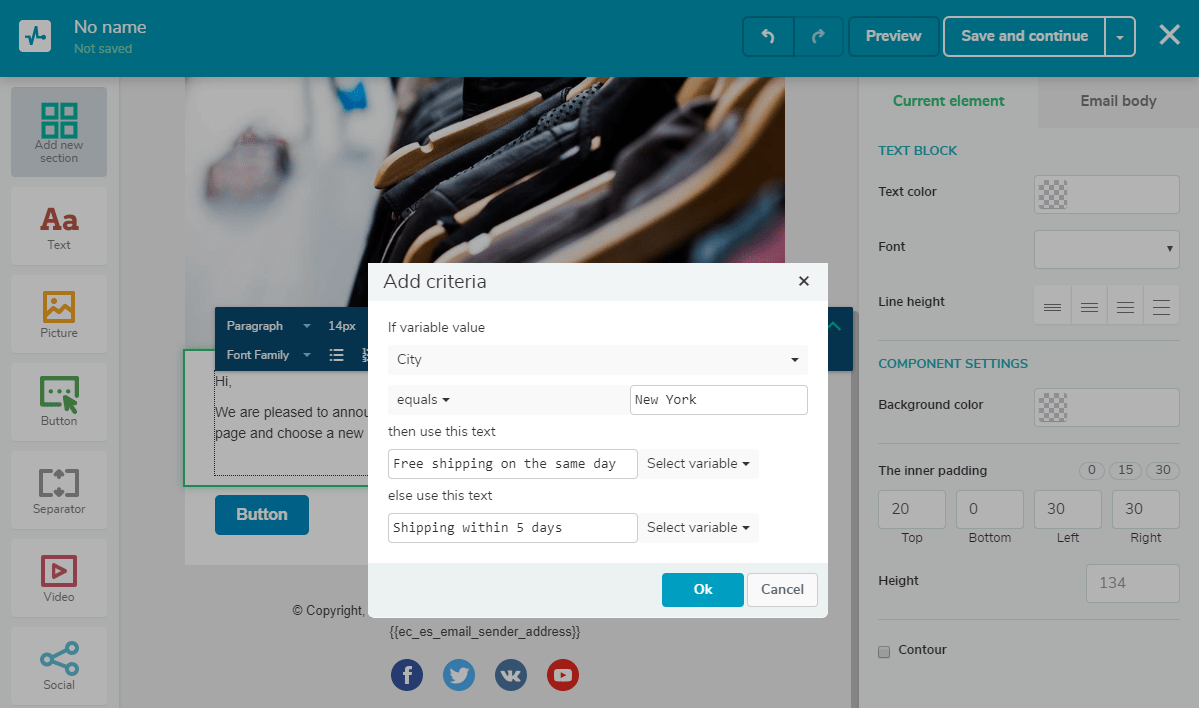
7 Tactics to Improve Your Customer Lifetime Value
- Upsell and cross-sell your products
- Consistently make special offers
- Improve the buying experience
- Re-engage dormant customers
- Start a loyalty program
- Revamp your customer service
- Build relationships with customers
Customer lifetime value is a complex concept, which encompasses various parts. So, marketers have found a variety of ways to enhance LTV by boosting each metric in its equation. Let’s unpack a few tactics you can use to improve this indicator.
Upsell and cross-sell your products
If the value of a purchase is the weakest spot in your LTV, consider upselling your product or service. This tactic works great for expensive products that customers rarely buy. For instance, you can’t sell a washing machine to one person every week, but you can increase the purchase value by offering a prolonged warranty or additional services.
Another option to consider is cross-selling, which implies offering complementary products. Let’s return to the washing machine example – you can show supplemental goods, such as water softener or laundry detergent.
Cross-selling is the favorite method of clothes retailers. The main trick here is to offer items that complement each other, such as a pair of jeans to a sweater. Here is an example from Farfetch – the brand shows you the whole look rather than a bundle of similar garments.
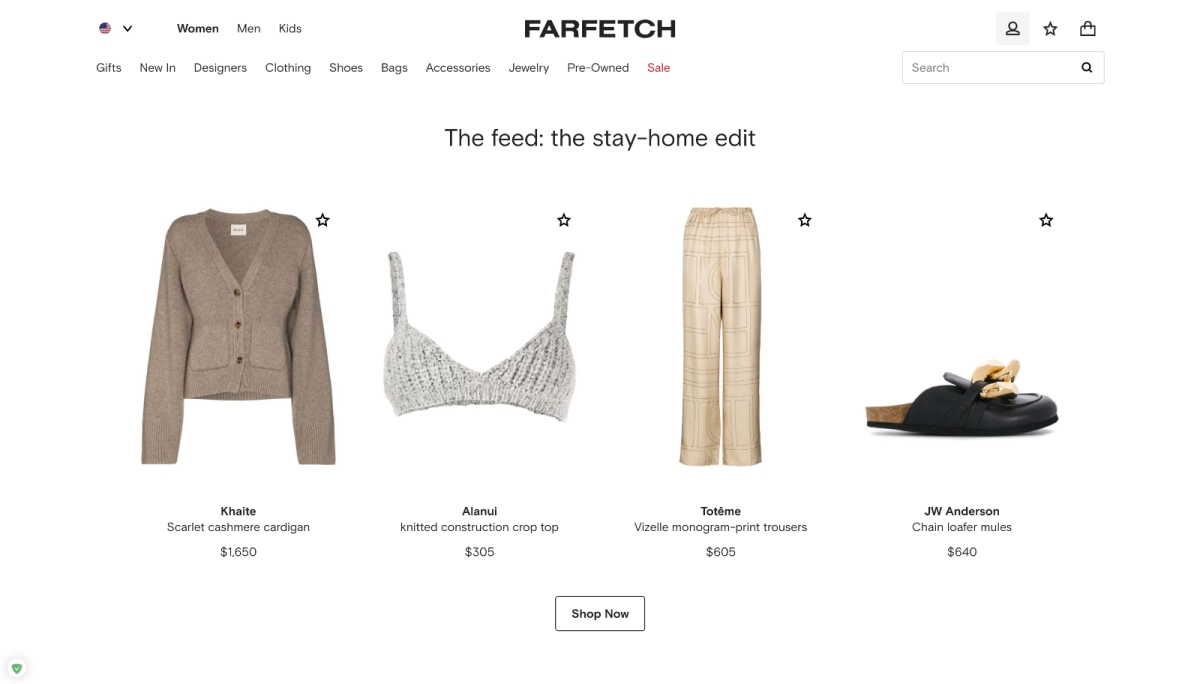
Consistently make special offers
Timely and regular special offers and discounts are a golden opportunity to boost your shopping frequency. Customers will probably buy something from a brand they are familiar with, especially when it offers special conditions.
To drive the best results, offer discounts several weeks after a previous purchase. Your customers still remember their last transaction and your brand in general, so they are more likely to buy from you again.
Another trick here is to offer a discount when purchasing two or more items. This way, you encourage a customer to spend more and stimulate the value of a purchase increase. Here is a perfect example of a special offer from Topshop. The brand uses a simple scheme – the more a customer spends, the bigger discount they get.
Improve the buying experience
A great experience underlies the longevity of your relationships with buyers and, as a result, your customer lifetime value. If your customers struggle to find the items they need or get kicked off during the purchase, they probably won't stay with you for long.
To make your customer experience exceptional, start by revising your website and optimize it for convenience. Make sure your website is easy to navigate and mobile-friendly, as mobile devices account for over 52% of internet traffic worldwide.
Examine your website for barriers customers may face during their journey to purchase. One of the examples here is excessive registration forms. They help you segment customers right from the start but intimidate customers. To coordinate your business needs with clients’ preferences, try multi-step forms – they show fields gradually after a customer starts filling them in.
Create beautiful responsive registration forms with SendPulse for free. With our tool, you can build forms in minutes and sign up your customers to their preferred channels, such as email, Facebook Messenger, or Telegram.
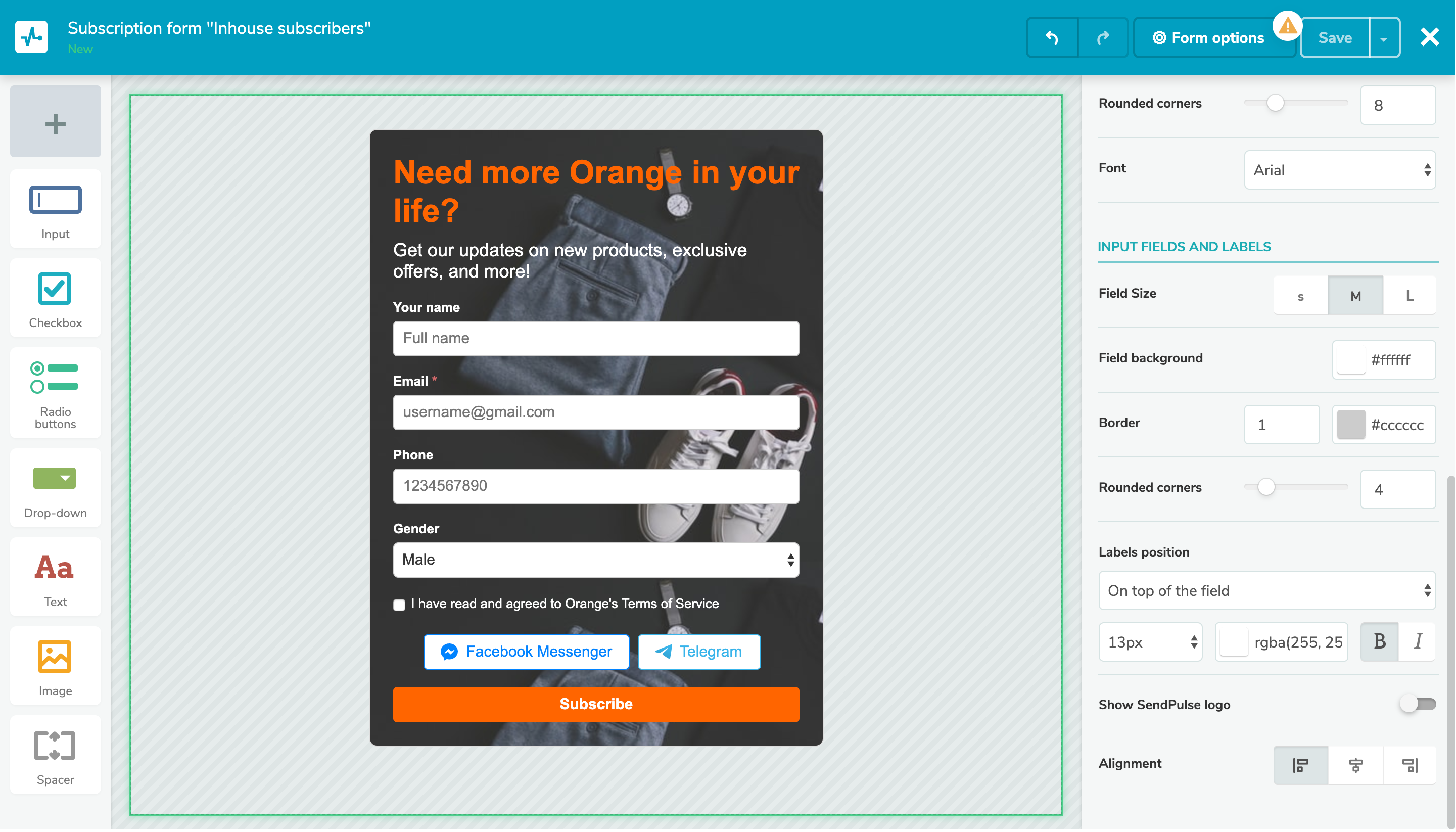
Re-engage dormant customers
In today’s world, people are often jaded with information and offers from brands. They easily get distracted and may stop buying from you just because they forget about your brand. So, it’s a good idea to remind dormant customers about your brand from time to time.
The easiest way to do so is with email marketing. Email platforms, such as SendPulse, allow you to keep track of your subscribers' activity and send re-engagement messages automatically. All you have to do is set up a flow that starts six months after a subscriber stopped engaging with your emails. SendPulse will automatically send these messages at the right time.
Craft your re-engagement email carefully – they should be subtle, not hard-selling. Start a message by asking your customer how they are and whether they are interested in returning to your website. The best way is to send not a single message but an email series. Follow our guide on launching a re-engagement email flow to craft a perfect campaign.
Let’s learn from the cosmetic retailer, Aillea. From the first lines of its message, the company creates the impression of caring. It chooses words thoughtfully and asks gentle questions rather than pushing the recipient towards a purchase. Nevertheless, Aillea includes clear calls to action to browse its new collection.

Start a loyalty program
Using psychological tricks is a great way to meet your business objectives. The one that will come in handy for boosting LTV is rewarding customer loyalty. Keep your buyers engaged with your brand by implementing a loyalty program.
A loyalty program is a powerful tool – it provokes nearly 80% of consumers to continue doing business with brands. However, not every loyalty program works effectively. To drive results, make sure your program offers various treats, including exclusive products, and engages with people.
Learn how to craft a loyalty program from the cosmetic brand Tarte. Program members get points along with other benefits like access to exclusive sales and offers, gifts for birthdays, anniversaries, and additional purchases, as well as exclusive products. The company gives points for a sign-up with the brand's emails, purchases, and activities on social media. This way, Tarte keeps customers engaged with a brand for long hauls and creates buzz on social networks, and attracts new customers.
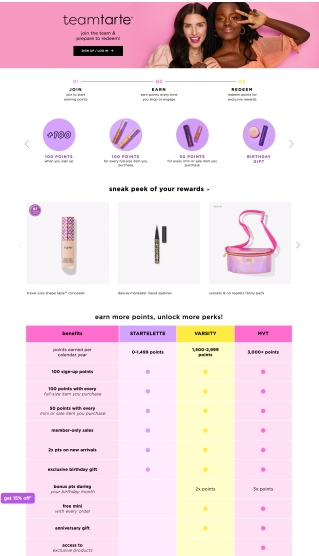
Revamp your customer service
Improving your customer service can be a game-changer for your customer lifetime value. According to a Microsoft report, high-quality customer service is a crucial factor of loyalty for 96% of people. On the other hand, poor service is the main reason to switch companies for more than 50% of customers.
Bear in mind that customer standards keep growing – your buyers anticipate your representatives to be available any time through various channels. Moreover, they want immediate responses.
To provide a high-quality yet cost-effective service, consider applying chatbots to your marketing strategy. They can handle requests from customers in an instant, and answer up to 80% of routine questions.
Here is an example of a customer support chatbot on Facebook from ManyChat. The bot offers customers a solution in the ManyChat knowledge base and Facebook community or creates a ticket for a support team. It saves tons of resources on the initial steps of tackling customer issues.
Chatbots are applicable for the majority of communication channels, so your customers can interact with them through their favorite social network or messenger. Better yet, this tool is easy and cheap to create and maintain. Build your chatbot for Facebook or Telegram with SendPulse – we offer up to three bots and 10,000 messages for free.
Build relationships with customers
The best way to increase LTV is to build a close emotional connection between your brand and its customers. Such an approach allows you to acquire more loyal buyers. Your current customers become brand advocates and recommend your brand to their friends, family, colleagues, and so on. And word of mouth is still the cheapest and one of the most reliable customer acquisition sources.
If you want to keep your customers tight-knit with your brand, explore the possibilities of relationship marketing. The core principles of this strategy are consistent, yet unobtrusive interaction with your buyers. Deliver value with every piece of communication rather than just selling goods. The best way to do so is to spot the barriers your customers may face during their interaction with your product and help them solve their problems.
You can also move to a pro-level and help your audience tackle their professional issues in general. Take a glance at the email below, where Wordstream advises a recipient on how to nail the holiday advertising this year. In this message, the brand offers its customers support and the tactics they need to achieve their goals.
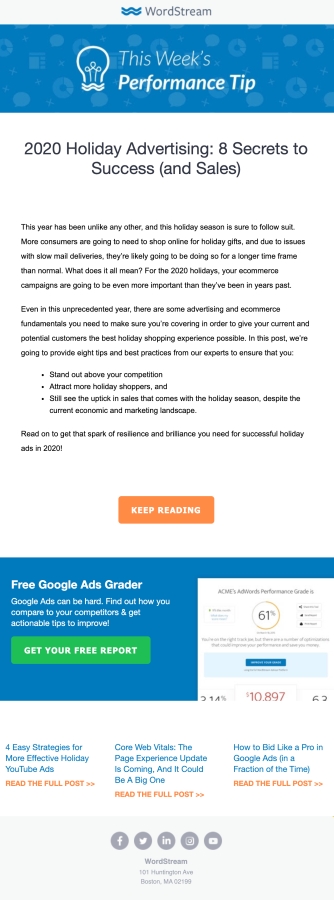
Customer lifetime value is a metric that can help your business reach its goals. To adopt the best practices, and employ tactics for LTV improvement with ease, sign up with SendPulse. We’ll provide you a bundle of tools to leverage your goals.
Last Updated: 26.06.2023

or